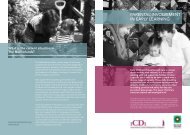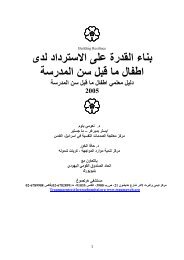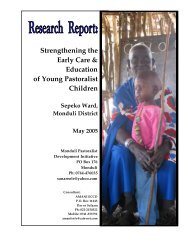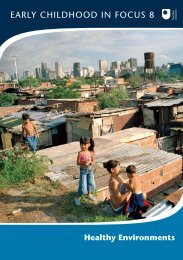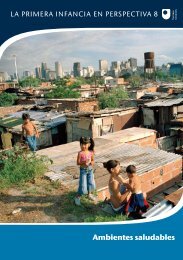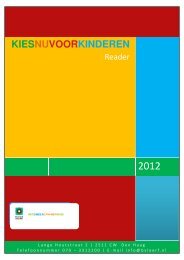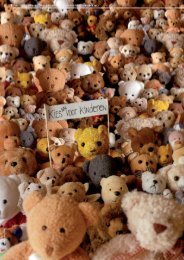Раннее деÑÑÑво и наÑалÑное обÑазование - Bernard van Leer ...
Раннее деÑÑÑво и наÑалÑное обÑазование - Bernard van Leer ...
Раннее деÑÑÑво и наÑалÑное обÑазование - Bernard van Leer ...
- No tags were found...
You also want an ePaper? Increase the reach of your titles
YUMPU automatically turns print PDFs into web optimized ePapers that Google loves.
ЛитератураAlidou, H., Boly, A., Brock-Utne, B., Diallo, Y.S., Heugh, K. and Wolff, H.E. (2005) ‘Optimizinglearning and education in Africa – the language factor. A stock-taking research on mothertongue and bilingual education in Sub-Saharan Africa’, paper presented at the Conference onBilingual Education and the Use of Local Languages, Windhoek, 3–5 August, ADEA/UNESCO/GTZ.Arnold, C. (2004) ‘Positioning ECCD in the 21st century’, Coordinators’ Notebook, no. 28, Toronto,The Consultative Group on Early Childhood Care and Development.Arnold, C., Bartlett, K., Gowani, S. and Merali, R. (2006) ‘Is everybody ready? Readiness, transitionand continuity: reflections and moving forward’, background paper for EFA Global MonitoringReport 2007, Paris, UNESCO.Association for the Development of Education in Africa (ADEA) (2007) [online].http://www.adeanet.org/ (Accessed 14 June 2007).Barnett, W.S. and Boocock, S.S. (eds) (1998) Early Care and Education for Children in Poverty:Promises, programs, and long-term results, Albany, NY, SUNY Press.Barnett, W.S, Schulman, K. and Shore, R. (2004) Class Size: What’s the best fit? New Brunswick, NJ,National Institute for Early Education Research (NIEER) at Rutgers University.Belfield, C.R. and Nores, M. (2004) ‘Lifetime effects: the High/Scope Perry Preschool studythrough age 40’, Monographs of the High/Scope Educational Research Foundation, no. 14,Ypsilanti, MI, High/Scope Press.Bennett, J. (2006) ‘Schoolifying’ Early Childhood Education and Care: Accompanying pre-school intoeducation, public lecture at the Institute of Education, University of London, 10 May 2006.Benson, C.J. (2002) ‘Real and potential benefits of bilingual programmes in developingcountries’, International Journal of Bilingual Education and Bilingualism, vol. 5, no. 6, pp. 303–17.Blatchford, P., Goldstein, H., Martin, C. and Browne, W. (2002) ‘A study of class size effects inEnglish school reception year classes’, British Educational Research Journal, vol. 28, no. 2, pp.171–87.Campbell, F.A. and Ramey, C.T. (1994) ‘Effects of early intervention on intellectual and academicachievement: a follow-up study of children from low-income families’, Child Development,vol. 65, pp. 684–98.Charles, L. and Williams, S. (2006) ‘Early childhood care and education in the Caribbean’,background paper for EFA Global Monitoring Report 2007, Paris, UNESCO.Corsaro, W.A. and Molinari, L. (2005) I Compagni. Understanding children’s transition from preschoolto elementary school, New York, NY, Teachers’ College Press.Dahlberg, G. and Lenz Taguchi, H. (1994) Förskola och Skola – Tva skilda traditioner och visionen omen mötesplats (Preschool and School – About two different traditions and a vision of an encounter),Stockholm, HLS Förlag.Docket, S., Perry, B., Howard, P. and Meckley, A. (2000) ‘What do early childhood educators andparents think is important about children’s transition to school? A comparison between datafrom the city and the bush’, paper presented at the 1999 Australian Association for Research inEducation Annual Conference, Melbourne, November 1999, Coldstream, AARE.Dunlop, A. and Fabian, H. (eds) (2006) Informing Transitions in the Early Years, Maidenhead, OpenUniversity Press.Edwards, C., Gandini, L. and Forman, G. (eds) (1995) The Hundred Languages of Children: TheReggio Emilia approach to early childhood education, Norward, NJ, Ablex Publishing Corporation.Engle, P.L., Black, M.M., Behrman, J.R., Cabral de Mello, M., Gertler, P.J., Kapiriri, L. et al. (2007)‘Strategies to avoid the loss of developmental potential in more than 200 million children inthe developing world’, Lancet, vol. 369, no. 9557, pp. 229–42.Folque, M. (2002) ‘O Jardim de Infância e o 1 o Ciclo: o que dizem os meninos’ (‘Kindergarten and1st Grade: what the children say’), paper presented at the III Simpósio do GEDEI – PráticasEducativas: Transições e transversalidades, Évora, GEDEI.Germeten, S. (1999) ’Nærstudier av fem 1. klasser, skoleåret 1998/99’ (’Detailed studies of fivefirst classes in the school year 1998/99’), Part Report 2, evaluation of Reform 97 På vei motNy Grunnskole i Oslo (Towards a New Compusory School in Oslo), no. 82-579-0310-8, Oslo, OsloUniversity College.Grantham-McGregor, S., Cheung, Y.B., Cueto, S., Glewwe, P., Richter, L. and Strupp, B. (2007)‘Developmental potential in the first 5 years for children in developing countries’, Lancet,vol. 369, pp. 60–70.Haug, P. (1995) ’Om politsik styring av utdanningsreformer’ (‘On the politics of educationalreforms’), in Skram, D. (ed.) Det Beste fra Barnehage og Skole – En ny småskolepedagogikk(The best of kindergarten and school – a new pedagogy for young children), Oslo, Tano.Haug, P. (2005) ’Rammeplan på tynt grunnlag’ (‘Framework curriculum on a shaky basis’), BedreBarnehager Skriftserie (Better Kindergarten Publication Series), vol. 1, no. 2, pp. 23–35.Hovens, M. (2002) ‘Bilingual education in West Africa: Does it work?’, International Journal ofBilingual Education and Bilingualism, vol. 5, no. 5, pp. 249–66.Ilg, F.L. and Ames, L. (1965) School Readiness: Behaviour Tests Used at the Gesell Institute, New York,NY, Harper & Row.Kagan, S.L. (1990) ‘Readiness 2000: rethinking rhetoric and responsibility’, Phi Delta Kappa,vol. 72, pp. 272–9.Korpi, B.M. (2005) ‘The foundation for lifelong learning’, Children in Europe, vol. 9, pp. 10–11.Larsen, A.K. (2000) ’Overgang fra barnehage til skole’ (‘Transition from kindergarten to school’),in Haugen, R. (ed.) Barn og Unges Læringsmiljø: Fra enkeltindivid til medlem av et flerkultureltfellesskap (Children and Young People’s Learning Environment: From individual to multiculturalcommunity), Kristiansand, Høyskoleforlaget.Lewin, K. (2007) Improving Access, Equity and Transitions in Education, Consortium for Research onEducational Access, Transitions and Equity, Monograph 1, Lewes, University of Sussex; alsoavailable online at http://www.create-rpc.org/publications/pathwaystoaccesspapers.shtml(Accessed July 2007).Lpfö (1998) Läroplan för Förskolan (National Curriculum for Preschool). Stockholm,Utbildningsdepartementet (Ministry of Education and Science).May, C.R. and Campbell, R. (1981) ‘Readiness for learning: assumptions and realities’, Theory toPractice, vol. 20, no. 2, pp. 130–4.Mwaura, P. (2005) Preschool Impact on Children’s Readiness, Continuity, and Cognitive Progress atPreschool and Beyond: A case for Madrasa Resource Centre Programme in East Africa, unpublishedreport. Geneva, Aga Khan Foundation.Myers, R.G. (1992) The Twelve Who Survive, London, Routledge.Myers, R.G. (1997) ‘Removing roadblocks to success: transitions and linkages between home,preschool and primary school’, Coordinators’ Notebook, no. 21, Toronto, Consultative Group onEarly Childhood Care and Development (CGECCD) Secretariat.Myers, R. and Landers, C. (1989) ‘Preparing children for schools and schools for children’,discussion paper for CGECCD, Toronto, CGECCDNational Institute of Child Health and Human Development (NICHD) Early Child Care ResearchNetwork (2000) ‘Characteristics and quality of child care for toddlers and preschoolers’,Applied Developmental Sciences, vol. 4, pp. 116–35.Neuman, M.J. (2005) ‘Global early care and education: challenges, responses, and lessons’, PhiDelta Kappa, vol. 87, no. 3, pp. 188–92.Neuman, M.J. and Peer, S. (2002) Equal from the Start: Promoting educational opportunity forall pre-school children – learning from the French experience, New York, NY, French-AmericanFoundation.64 65




